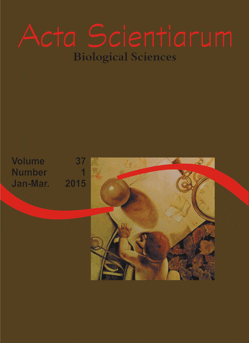<b>Temporal variation of soil entomofauna from an urban forest fragment in southern Brazil
Resumo
Insects are important environmental bioindicators, due to the species diversity and wide range of habitats occupied. The present study evaluated the temporal variation in composition and abundance of soil insects in an urban forest fragment in the municipality of Toledo, in the state of Paraná, by analyzing their abundance and seasonality. Monthly samplings were conducted between August 2011 and July 2012 at four sampling sites within the fragment. At each site, three pitfall traps remained exposed for 48 hours. Captured insects were fixed in alcohol, sorted and identified. Throughout the study period, we captured 11,568 insects from 11 orders and 35 families. Coleoptera was the richest order (12 families), followed by Diptera and Hemiptera (5), Hymenoptera and Orthoptera (3). The order Hymenoptera was the most abundant (4,789 individuals), followed by Coleoptera (4,630) and Diptera (1,985). Coleoptera was represented mainly by the families Staphylinidae and Silphidae. Formicidae (Hymenoptera) was the least abundant in colder months. Collembola was positively correlated with soil moisture. In general, the insect fauna in the forest fragment exhibited characteristics of the fauna from impacted habitats, that is, low diversity of families and dominance of generalist groups.
Downloads
DECLARAÇÃO DE ORIGINALIDADE E DIREITOS AUTORAIS
Declaro que o presente artigo é original, não tendo sido submetido à publicação em qualquer outro periódico nacional ou internacional, quer seja em parte ou em sua totalidade.
Os direitos autorais pertencem exclusivamente aos autores. Os direitos de licenciamento utilizados pelo periódico é a licença Creative Commons Attribution 4.0 (CC BY 4.0): são permitidos o compartilhamento (cópia e distribuição do material em qualqer meio ou formato) e adaptação (remix, transformação e criação de material a partir do conteúdo assim licenciado para quaisquer fins, inclusive comerciais.
Recomenda-se a leitura desse link para maiores informações sobre o tema: fornecimento de créditos e referências de forma correta, entre outros detalhes cruciais para uso adequado do material licenciado.












1.png)




3.png)













